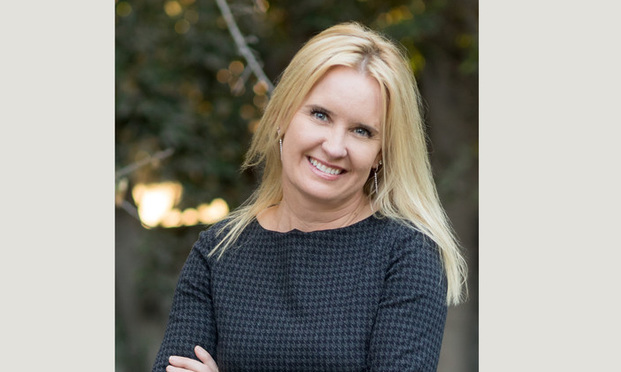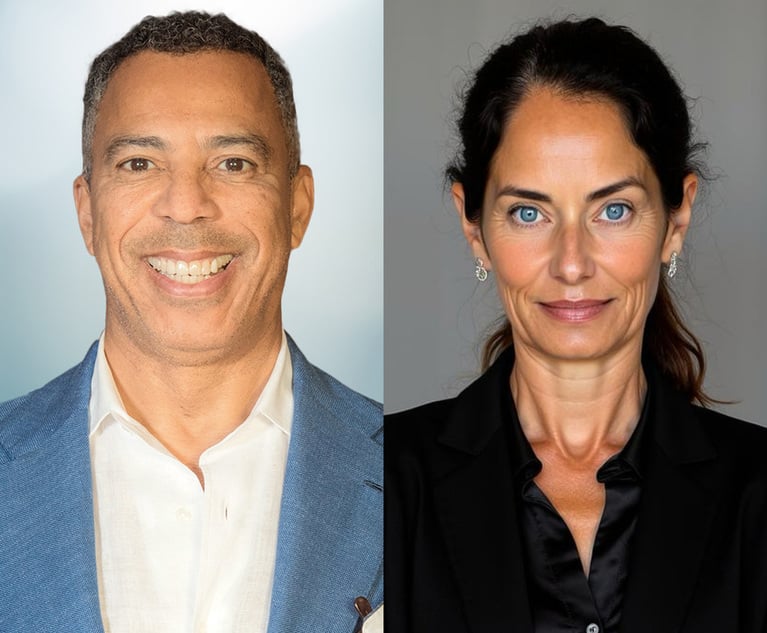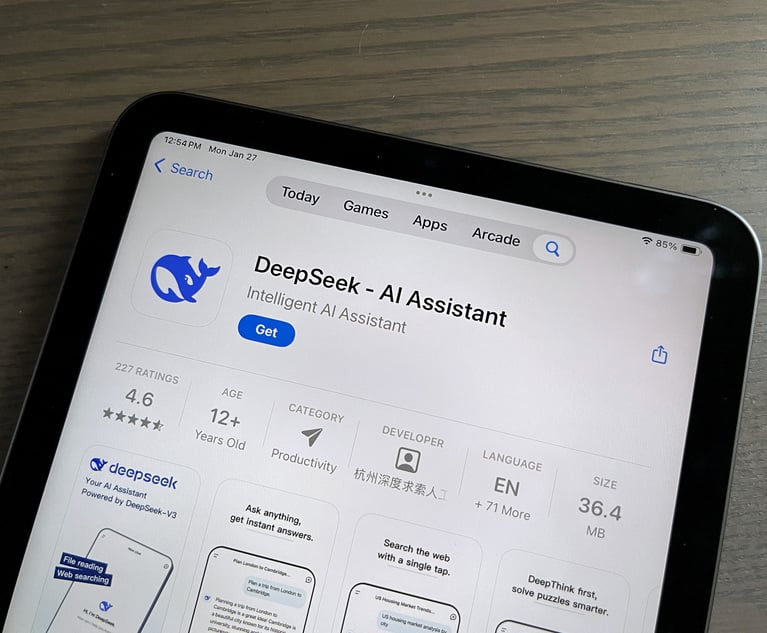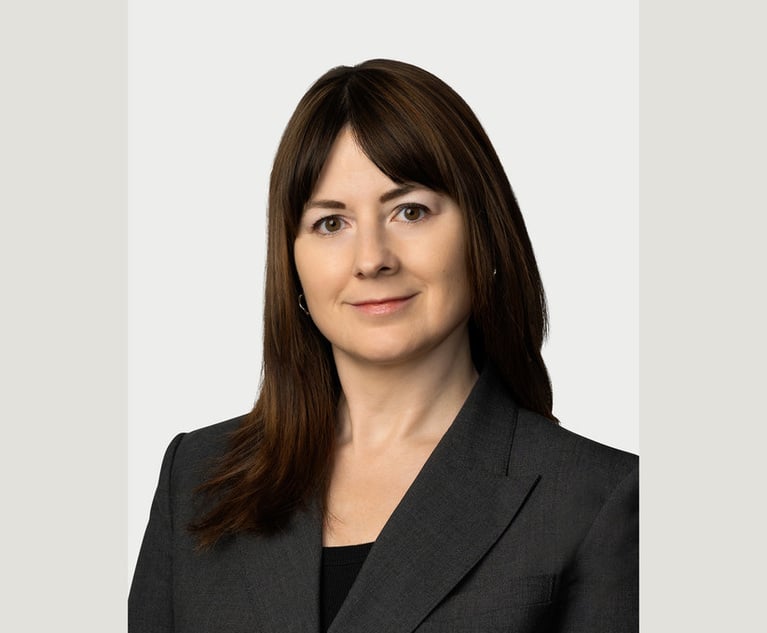Litigation Leaders: Latham's Michele Johnson on Client Service, Team Culture and Playing to Win
'We don't just neutralize the other side's best facts; we incorporate them as part of our affirmative story. '
November 19, 2019 at 12:02 AM
13 minute read
The original version of this story was published on Litigation Daily
 Michele Johnson of Latham
Michele Johnson of Latham
It's time for the November installment of our Litigation Leaders series showcasing the litigation practice heads of the nation's biggest law firms. This month we're featuring Michele Johnson, the global chair of Latham & Watkins' litigation and trial department.
Based in Orange County, California, Johnson maintains a vigorous full-time practice representing financial institutions, Fortune 500 companies, boards of directors and individuals in securities, M&A, and other complex commercial litigation.
Lit Daily: Tell us a little about yourself—beyond what's in your law firm bio.
Michele Johnson: My early background may not have immediately recommended me for a Litigation Leader interview, or the privilege of chairing the litigation and trial department at one of the world's great law firms.
I was a self-taught homeschooler through high school, with little access to the world beyond the walls of home or church. I worked through community college (Taco Bell drive-thru), and on a transfer scholarship was admitted to Arizona State University, then law school at Georgetown. I joined Latham upon graduation in 1998, and participated in my first trial in early 2000 for an aviation company in a tax dispute in Orange County Superior Court.
One thing that happens when you grow up cut off from everyone else's culture is that you learn to be calm in unfamiliar circumstances. This instinct has been helpful, I think, both in navigating cutting-edge corporate crises and in empathizing with diverse perspectives, whether of jurors, judges, clients or colleagues.
Outside of representing clients in court and leading the department, I spend as much time as possible with my passel of children—my daughter Emily, who's 12, my nieces Quinn and Kaede, 5 and 13, and my nephew Isaac, 11. They run my house (mostly Quinn does), loosely supervised by my sister Melody, and are into volleyball, football, guitar, drum-line, visual art and creative writing. And when there's time, I run, bake and play keyboards in two rock & roll bands.
How big is your litigation department and where are most of your litigators concentrated geographically?
We have 750 lawyers in the litigation and trial department, spread over the globe. We serve our clients and staff our cases cross-office and cross-practice group, fielding the best team matched to each client. That said, our offices that are home to the most litigators are New York, Washington, D.C., London and San Francisco.
In what three areas of litigation do you have the deepest bench? (I know it's tempting to list more, but please just name three)
So difficult to narrow it down! But I'll highlight three here. First, our complex commercial litigation practice, led by Sean Berkowitz (of Enron fame), is racking up impressive trial wins across the globe. For some time, Latham has been best known for its specialized litigation practices, including securities, antitrust, IP, and white collar. While these practices remain top of class, Sean's group has been scoring massive wins in high-stakes commercial litigation, including recent notable trial wins for Oracle and DXC. This group is also dominating the data privacy and cybersecurity space, with major mandates from Facebook and other industry leaders.
Second, our white-collar defense and investigations practice, led by Kathy Ruemmler (President Obama's White House counsel), is amassing world-class accolades, guiding companies such as Cognizant, Microsoft and OSI Systems to favorable resolutions of foreign bribery cases. This star-studded practice includes Alice Fisher and Leslie Caldwell, each a former assistant attorney general in charge of the Criminal Division of the US DOJ, during the Bush and Obama administrations, respectively.
Third, our securities litigation and professional liability practice group, led by Andy Clubok, has achieved remarkable successes, including a rare securities fraud class action jury trial victory he and I achieved for Puma Biotechnology this year.
As head of the department, what are some of your goals or priorities?
Our top priorities are to deliver the absolute highest level of client service, achieve excellent results, and continue to innovate with our clients. I also want to make sure we effectively communicate to the world about our trial wins, our stars, our deep bench, and our string of powerhouse victories at all stages of litigation.
Because Latham does not have a star system—but rather a team culture, cultivated by our 20-year managing partner, Bob Dell, and continued by Rich Trobman today—we tend not to be self-promoters. I will forever be incredibly proud of that culture. In my over two decades at Latham, never once has a colleague declined my request for help. They have flown overseas on hours' notice, canceled weekend trips to help with TROs, and pulled all-nighters to proof a critical brief. I would never trade away the sense of team spirit and comradery we have built at Latham. Part of my role is to work with those teams to tell Latham's story. Fortunately, we have the facts to back us up.
As our profession continually evolves, we relish collaborating with our clients to define and deliver value. We are engaging in discussions every day regarding alternative fee arrangements to creatively price services, including partial or full contingency arrangements, in order to provide predictability and mutual economic benefit. We have achieved spectacular successes for our clients this year in ways that align interests and reward flexibility. With our record of success, we are more than happy to bet on ourselves and, above all, enjoy partnering with our clients to achieve the best results possible.
Another top priority is to deliver diverse teams and talent. It is beyond dispute that diverse teams are the best teams. We work tirelessly to develop and promote diverse attorneys and to foster a culture of inclusiveness. This year, six of our biggest trials—each in a different venue involving a different industry and a different practice—were led by women. I wonder if any other firm can say the same?
Finally, pro bono continues to be a top priority. Last year, Latham provided nearly $180 million in free legal services, including for disabled veterans, asylum seekers, victims of domestic abuse, and the homeless.
I was recently part of a team that unlocked $70 million for emergency housing and mental health services for Orange County's homeless, after a mass eviction from the encampments along the Santa Ana Riverbed near Angels Stadium in Anaheim. Two weeks ago, associate Elana Nightingale Dawson, a former Supreme Court clerk, led a team in a week-long evidentiary hearing in federal court for a death row inmate in Alabama—supported by Greg Garre, former Solicitor General of the United States and the head of our Supreme Court and appellate practice, and partner Jonathan Su, chair of the firm's pro bono committee.
What do you see as hallmarks of your firm's litigators? What makes you different?
Latham is not built on a star system around a few leads who parachute into trials. Rather, we have a constellation of outstanding, experienced, first-chair trial lawyers, with proven track records and a willingness to do just about anything for our clients and each other, without regard for who's in charge or who gets top billing. This fluid teamwork gives our clients an uncommon advantage. We go to war with a team of experienced litigators, who will support each other or divide up the case without any drop-off in the level of advocacy.
This approach also allows us to train and develop our next generation of trial lawyers, as our experienced litigators are pleased to take the second chair at trial and support the younger lawyers as they take lead roles.
Additionally, Latham is not limited in our prowess by industry. We represent major companies in virtually every industry from technology companies including Facebook, Lyft, Apple, and SAP, pharma giants Johnson & Johnson and AbbVie, and biotechnology companies like Puma Biotechnology and Sarepta Therapeutics, to retail clients like Walmart and Chipotle and multinational conglomerates including GE and Phillip Morris.
Clients hire Latham litigators because we understand their truly dynamic industries and are able to pair that fluency with the vast resources of our multidisciplinary, global platform. And while we always work to achieve the best result for our client's commercial interests—often an early dismissal or favorable resolution—we adopt a trial-ready strategy at the outset of any dispute so we're always several steps ahead of the opposition.
The results? We've had an unprecedented number of marquis wins in 2019 including by teams led by young, diverse trial lawyers.
How many lateral litigation partners have you hired in the last 12 months? What do you look for in lateral hires?
Latham's lateral-partner hiring strategy has remained constant throughout our firm's history: We attract the world's top talent, but only where the candidates share our sense of culture, embracing collegiality, commitment, collaboration, dedication, and teamwork.
Our four hires into the department this year continue to strengthen the depth of our expertise throughout our global platform: international competition and merger control lawyer David Little in London, complex commercial and restructuring litigator Oscar Franco in Madrid, transactional benefits and employment litigator Anne Kleffmann in Munich, and copyright and music licensing pro Joe Wetzel in San Francisco.
I would also note, we recently voted to admit into the department eight new partners from our associate ranks, adding further depth to our complex commercial, IP, white collar and securities litigation practices with diverse lawyers who have demonstrated an unwavering commitment to client service, team play, and an ability to think strategically and creatively.
What were some of your firm's biggest in-court wins in the past year?
Starting with our Litigator of the Week honors, we won a massive patent case in Delaware led by Mike Morin and David Frazier for Johnson & Johnson involving its blockbuster Darzalex product, and achieved an unlikely pretrial win in Los Angeles led by Laura Washington and Marvin Putnam for Miramax relating to the Harvey Weinstein scandal.
We were finalists for the honor in a number of other cases, including a defense verdict for Oracle in a breach of contract jury trial in San Francisco led by Sarah Ray; a $666 million arbitration win for DXC in a post-merger case against Hewlett-Packard led by Jamie Wine; a milestone pro bono challenge to San Francisco's cash bail system led by Sadik Huseny and Bob Sims; a defense verdict for Adobe in a high-stakes patent trial in Virginia led by Tara Elliott, Mike Morin, and Max Grant; and, just last week, a $36.5 million jury verdict for owners of a revolutionary e-commerce fashion company, led by Dan Schecter.
Among dozens of other victories this year, we won the securities class action trial I mentioned for Puma Biotechnology, in which a California jury awarded minimal damages on a $1.2 billion claim. We prevailed in a bellwether case in Colorado led by Mary Rose Alexander, who convinced the jury to reject a vast majority of claims and zero out the high-risk punitive and treble damages.
Maggy Sullivan and Larry Buterman won our third dismissal of the year for energy clients in antitrust actions, and our Paris-based colleagues Fernando Mantilla-Serrano and John Adam scored a major ICC arbitration success for RECOPE, Costa Rica's State-owned refining company. Finally, we tried a $1 billion case for UBS in New York against Highland Capital, led by Andy Clubok and Beth Deeley.
Can you give an example or two of tactics that exemplify your firm's approach to litigating cases?
While everyone focuses on knowing their own case, we aim to know the other side's case better than they do. In jury research exercises, our lead lawyers play the role of our opponents, in order to present the strongest possible counter.
This blue team/red team approach gets fiery, but it allows us to identify, appreciate and address our potential weaknesses in order to turn them into strengths. We don't just neutralize the other side's best facts; we incorporate them as part of our affirmative story.
We also jettison weak, or even decent, arguments in order to focus on our strongest ones. Study after study shows that football coaches often punt when they should go for it on fourth down to avoid being second-guessed. They play not to lose instead of playing to win. Litigators, similarly, often try to preserve every possible argument, for fear of being accused of cutting a potentially winning point.
But this approach can kill a lawyer's credibility, as well as the focus and attention paid by the judge or jury to the strongest evidence. In two of our major 2019 wins, our patent litigators conceded infringement, and went all in on their stronger invalidity defenses. Both calls led to complete defense verdicts. Litigation requires difficult decisions and conviction. We play to win.
Where are you looking to build or expand in the next year?
Our teams are taking the market by storm in the areas of data privacy and cybersecurity, copyright and music licensing, restructuring, Securities Act IPO litigation, and several other cutting-edge areas of litigation. We plan to tell those stories because they will matter.
See our other Litigation Leaders profiles:
Quinn Emanuel's Diane Doolittle on Show Jumping, Street Smarts and Bet-the-Company Cases
Cooley's Mike Attanasio on Strategy, Lateral Hires and Training New Trial Lawyers
We hope you enjoyed this excerpt from Litigation Daily, the exclusive source for sharp commentary on mega court battles, winning strategies and the issues that obsess elite litigators. Click here to subscribe.
This content has been archived. It is available through our partners, LexisNexis® and Bloomberg Law.
To view this content, please continue to their sites.
Not a Lexis Subscriber?
Subscribe Now
Not a Bloomberg Law Subscriber?
Subscribe Now
NOT FOR REPRINT
© 2025 ALM Global, LLC, All Rights Reserved. Request academic re-use from www.copyright.com. All other uses, submit a request to [email protected]. For more information visit Asset & Logo Licensing.
You Might Like
View All
Growth of California Firms Exceeded Expectations, Survey of Managing Partners Says
5 minute read
The Time Is Now for Employers to Assess Risk of Employees’ Use of DeepSeek
4 minute read
Loopholes, DNA Collection and Tech: Does Your Consent as a User of a Genealogy Website Override Another Person’s Fourth Amendment Right?
Law Firms Mentioned
Trending Stories
- 1NJ Jury Awards $4.5M After Woman Trips on Carpet
- 2Blake Lively Is Sued by Texas Crisis Specialist in Latest 'It Ends With Us' Lawsuit
- 3Pa. High Court to Decide Whether Flight in a High Crime Area Can Result in an Investigative Stop
- 4EB-5 Immigration Investor Program: a Win-Win Program, or Is It?
- 5People in the News—Feb. 6, 2025—Unruh Turner, Fox Rothschild
Who Got The Work
J. Brugh Lower of Gibbons has entered an appearance for industrial equipment supplier Devco Corporation in a pending trademark infringement lawsuit. The suit, accusing the defendant of selling knock-off Graco products, was filed Dec. 18 in New Jersey District Court by Rivkin Radler on behalf of Graco Inc. and Graco Minnesota. The case, assigned to U.S. District Judge Zahid N. Quraishi, is 3:24-cv-11294, Graco Inc. et al v. Devco Corporation.
Who Got The Work
Rebecca Maller-Stein and Kent A. Yalowitz of Arnold & Porter Kaye Scholer have entered their appearances for Hanaco Venture Capital and its executives, Lior Prosor and David Frankel, in a pending securities lawsuit. The action, filed on Dec. 24 in New York Southern District Court by Zell, Aron & Co. on behalf of Goldeneye Advisors, accuses the defendants of negligently and fraudulently managing the plaintiff's $1 million investment. The case, assigned to U.S. District Judge Vernon S. Broderick, is 1:24-cv-09918, Goldeneye Advisors, LLC v. Hanaco Venture Capital, Ltd. et al.
Who Got The Work
Attorneys from A&O Shearman has stepped in as defense counsel for Toronto-Dominion Bank and other defendants in a pending securities class action. The suit, filed Dec. 11 in New York Southern District Court by Bleichmar Fonti & Auld, accuses the defendants of concealing the bank's 'pervasive' deficiencies in regards to its compliance with the Bank Secrecy Act and the quality of its anti-money laundering controls. The case, assigned to U.S. District Judge Arun Subramanian, is 1:24-cv-09445, Gonzalez v. The Toronto-Dominion Bank et al.
Who Got The Work
Crown Castle International, a Pennsylvania company providing shared communications infrastructure, has turned to Luke D. Wolf of Gordon Rees Scully Mansukhani to fend off a pending breach-of-contract lawsuit. The court action, filed Nov. 25 in Michigan Eastern District Court by Hooper Hathaway PC on behalf of The Town Residences LLC, accuses Crown Castle of failing to transfer approximately $30,000 in utility payments from T-Mobile in breach of a roof-top lease and assignment agreement. The case, assigned to U.S. District Judge Susan K. Declercq, is 2:24-cv-13131, The Town Residences LLC v. T-Mobile US, Inc. et al.
Who Got The Work
Wilfred P. Coronato and Daniel M. Schwartz of McCarter & English have stepped in as defense counsel to Electrolux Home Products Inc. in a pending product liability lawsuit. The court action, filed Nov. 26 in New York Eastern District Court by Poulos Lopiccolo PC and Nagel Rice LLP on behalf of David Stern, alleges that the defendant's refrigerators’ drawers and shelving repeatedly break and fall apart within months after purchase. The case, assigned to U.S. District Judge Joan M. Azrack, is 2:24-cv-08204, Stern v. Electrolux Home Products, Inc.
Featured Firms
Law Offices of Gary Martin Hays & Associates, P.C.
(470) 294-1674
Law Offices of Mark E. Salomone
(857) 444-6468
Smith & Hassler
(713) 739-1250







